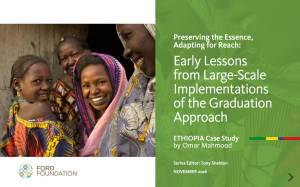Graduation Approach Case Study: Ethiopia
The Challenge
Despite economic progress, food security remains a major issue in Ethiopia, particularly in the country’s rural regions. The vast majority of Ethiopians rely upon agriculture as their main livelihood source. Recurrent climatic shocks have had a big impact upon communities, leading to periodic drought and food shortages. Starting in the early 2000s, the government of Ethiopia initiated several programs to move chronically food-insecure households out of extreme poverty and provide reliable insulation from shocks. These included direct support and public works programs, increasing access to rural credit, and training for livelihoods support. Mixed progress and slow exit rates from the programs indicated the need for other solutions.
What We Did
Ethiopia was one of the eight countries included in the first efforts by the Ford Foundation and the Consultative Group to Assist the Poor (CGAP) to adapt and test the Graduation Approach. A small pilot (with significant adaptations from the “classic” model) was implemented by the non-governmental organization, Relief Society of Tigray, in northern Tigray province from 2010 until 2012. Based on the positive results of the pilot, in 2015 the government of Ethiopia decided to undertake a large-scale expansion as an integral part of the national Productive Safety Nets Program (PNSP IV)–the fourth iteration of this extensive food security-focused program. Up to ten million social protection clients will be eligible for access to elements of the Approach between 2016 and 2020, with the poorest 30 percent specifically designated to receive asset transfers.
What We Learned
This case study was completed shortly before implementation of Ethiopia’s PSNP IV was scheduled to begin. However, it identifies key lessons learned from the Graduation Approach pilot and the challenges the government may face in expanding from a small pilot project in one province to Graduation Approach’s inclusion in a nationwide social protection program that involves up to 10 million participants.
These include:
“Despite the many challenges and considering the unenthusiastic initial reaction the Graduation Approach received in Ethiopia, the integration of the model into the country’s hallmark national-level social protection and livelihoods development program is a remarkable achievement.”
- There will be complications related to the scale and number of partners involved in the program. For example, implementation at scale has led to the value of the asset transfer being reduced to USD 200, an amount many consider to be too low. In addition, PSNP IV brings together a wide range of Ethiopian government ministries and other organizations on a much more extensive level than in the past, in an effort to provide specialized assistance. Combined with a shortened timeline to scale up the project, coordination at all levels and regions will be an immense implementation challenge.
- Appropriate staffing is one of the most important determinants of program success. While the government of Ethiopia is able to rely on a network of development agents already in place, a major challenge will be managing their increased workload, which includes providing coaching and monitoring, a hallmark of the Graduation Approach. To avoid overworking them and balance the need for personalized attention against the realities of large-scale implementation, PSNP IV will group participants into cohorts for training sessions that also emphasize peer-to-peer learning, while employing a range of government ministries and other partner organizations to provide structured technical training as well.
- The combination of local knowledge with participation at all levels is one of the key lessons influencing PSNP IV design, but also a challenge to replicate across all districts throughout the diverse nation. Local task forces are responsible for household targeting, which includes admission into PSNP IV, classifying the extent of consumption support, and determining the poorest to be eligible for asset transfers. In addition, the community task forces are charged with determining which households are ready for program exit, based on evidence and a case-by-case evaluation system rather than standardized benchmarks. That process is also not linked to specific timelines, in order to protect against premature exit. The livelihoods pathways will also be highly dependent on local input to identify viable opportunities for each region.
- The savings component in PSNP IV will be mandatory, but there is an awareness that this may be difficult to ensure given the realities of expanding the program to scale across the nation. The Ethiopian government has worked strenuously to avoid fostering a culture of dependency in its social protection programming. The success of the forced savings mechanism in the Tigray pilot has also led to the model of mandatory savings for asset transfer participants in PSNP IV, albeit with a recognition that this will be difficult to implement and savings mechanisms may vary locally. The development of successful locally-specific mechanisms to ensure clients save an appropriate amount may be a key factor in reducing concerns with regards to fostering dependency.
